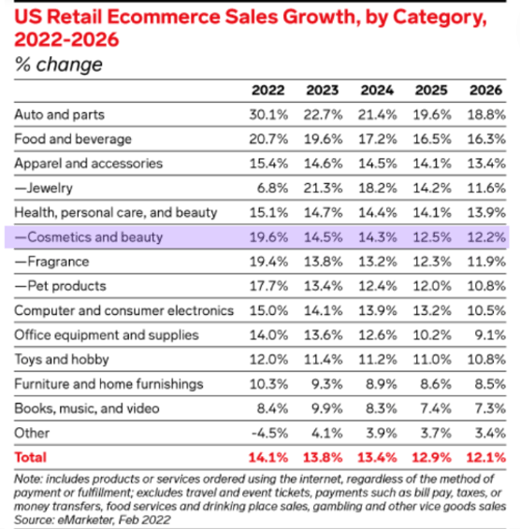Beauty is (still) booming: in 2022, total beauty sales rose 11% YoY. And though the growth rate might slow in 2023, ecommerce beauty sales are still expected to climb to $30.73B by 2026.
To engage with that growth, Facebook and Instagram ads should still hold a strong spot in your media strategy.
Facebook inventory is already crowded for beauty players, and the competition will only rise in step with the increasing sales. The importance of having a winning strategy and flawless tactical execution is more important than ever, so that your brand can fight for auction space on Facebook and Instagram.
FIVE ACTIONABLE STEPS TO SUPERCHARGE YOUR FACEBOOK CAMPAIGNS NOW
- Separate promotions and evergreen into their own campaigns.
The beauty industry is ripe with promotions and special sales for holidays and more. Promotions are a great way to acquire new customers, but all too often when we audit beauty accounts, we see promotions and evergreen content lumped together into the same campaigns, or worse yet, the same ad sets.
This is problematic because evergreen ads need to do their thing, uninterrupted. Also, when the two are together, the key promotions fight with longer-tenured evergreen ads. The latter may continue to be favored by Meta’s algorithm, thus leading to lower impression volume and spend.
The solution here is simple: run promotions out of a separate campaign from evergreen. This allows you to better control the budget, as well as any special audience targeting, and ensures that the promotional creative the design team put so much time and effort into will get the love it deserves.
- Your best-seller is your best bet, and it’s time to double down on best-sellers.
The winning ticket for beauty brands in 2023: a user generated, lo-fi customer testimonial mash-up video, with the user selling your brand’s best-seller in their own words. This creative type is an excellent way to reach new users with a compelling, trustworthy video. Not only does this creative work well for top of the funnel, but you can use it to retarget and retain audiences to help drive higher lifetime value.
The key to maximizing the mileage of the video is to proof it. Can you proof it? Yes, you can!
Proofing it means creating one original version of an ad. Then, grab the post ID from that ad, and make sure to use that exact post ID any time the ad is run against a new audience. This approach works to compound likes, comments, and shares, giving the ad an advantage with both Meta’s algorithm and the end user. The algorithm sees the ad receiving engagement and buzz, and so the algorithm will reward that ad with lower cpms, lower cpcs, etc. What’s more: consumers see the engagement on the ad and want to get in on the conversation. If there are a few hundred comments from people talking about how great the best-seller is, the ad becomes a best-seller selling machine!
Stella Rising Tip: Run the proofed ad against a VIP list of customers, and all past purchasers, too. Chances are, they are raving fans who will want to hop into the comments and share their love for the best-seller. This step ads an extra layer of validation for potential new customers, and the social proof drives more conversions for lower costs.
Don’t be afraid of “creative fatigue” with this best-seller creative. We still see top performing ads receive plenty of mileage, for several months and even longer in certain instances.
And DON’T let the conversation in the comments go without jumping in! If people have questions, answer them! If people have positive things to say, thank them! If people comment negatively, respond back and either say that you will message them privately or hide the comments.
- Broad targeting is beautiful: don’t over-segment. Meta is smart enough to know that your brand’s bread-and-butter customer is a female, aged 30-to-35, interested in serums and moisturizers. Don’t restrict the algorithm by limiting the targeting options it has. Instead, go broad. We’ve seen broad targeting work 15% better than segmented targeting for various beauty clients.
It’s important to note that when going broad, we recommend running this for conversion-based campaigns, where Meta tries to find the users who are most likely to take that desired conversion.
- DO use creator and other forms of User Generated Content (UGC). It’s easy to get stuck in high production value, carefully curated image and vivid video content, particularly for luxury beauty brands. However, Meta provides a blueprint to successful advertising with their Performance 5, and creator content is at the top of the list. Fit in to stand out. Feeds, stories and reels are chock-full of UGC content, because that’s what people are posting, and it’s what consumers want to see. From a macro level, Stella’s beauty clientele saw 28.5% lower CPAs on UGA/LOFI content in 2022 vs. HIFI.
- Take a look at your lookalikes. Running conversion lookalikes is separate from “purchaser” lookalike audiences based off of pixel or CRM data. This process requires a bit of technical set up, but it will set your brand up for success and give you a powerful targeting capability that we can guarantee most of your competitors do not have.
The competition on Meta for beauty brands will tighten in 2023 and beyond. Running successful, ROAS positive campaigns is no easy feat but implementing the five strategies and tactics above will help your brand shine brighter.
Additional Sources: NPD Group




COMMENTS